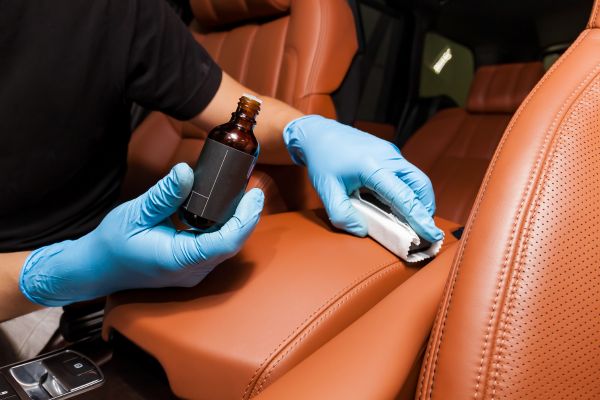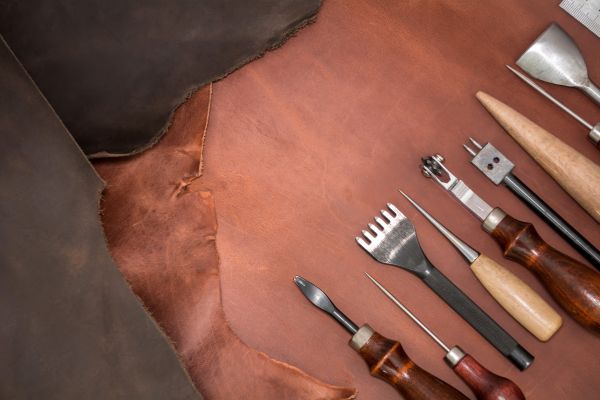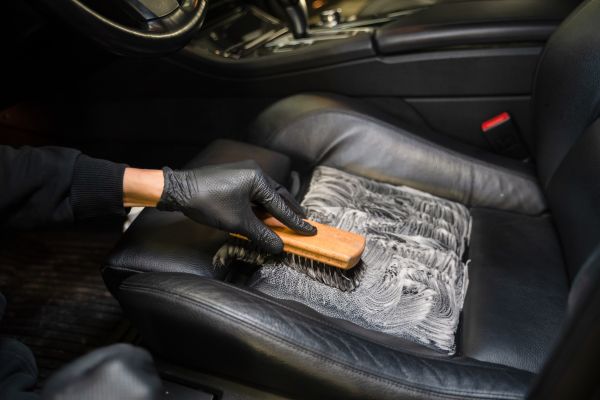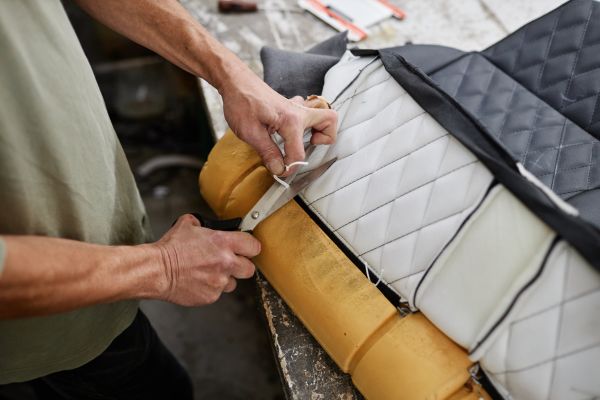Leather seats can add a touch of luxury and comfort to any car. However, with regular use, they can start to show signs of wear and tear—scratches, scuffs, and fading are common issues that can detract from their appeal. If you’re looking to restore your leather seats to their former glory, you’re in the right place.

In this guide on how to repair leather car seats, we’ll walk you through simple, effective steps to repair and maintain your leather upholstery. This will ensure your seats stay smooth, stylish, and durable for years to come. From small scratches to deeper tears, we’ll show you how to fix them with ease, so you can enjoy your ride in comfort and style.
Common Leather Car Seat Problems
Before learning about repairing leather car seats, it is helpful to know the common types of damage you may face. Most of these issues can be fixed with simple DIY repairs.

- Scratches and Scuffs : Caused by sharp objects or friction, these marks are usually easy to repair.
- Cracks and Tears : Leather can crack or tear over time, especially if it gets too dry or is exposed to wear.
- Stains : Spills from drinks, oils, or food can stain Leather, but with the right approach, it can often be cleaned.
- Fading : Leather seats can fade when exposed to excessive sunlight. This can often be fixed with leather dyes and conditioners.
Understanding the type of damage to your seats will help you choose the right repair method. Let’s examine how to fix leather car seats for each of these common problems.
Tools You’ll Need
To effectively repair leather car seats, you’ll need a few essential tools:

- Leather Cleaner : Specially designed for automotive Leather, it helps remove dirt, oils, and grime without damaging the material.
- Microfiber Cloths : These are gentle and won’t scratch your Leather.
- Leather Repair Kit : This typically includes:
- Leather filler
- Leather dye
- Applicators like brushes or sponges
- A finish or sealant to protect the Leather
- Leather Conditioner : To keep your Leather soft and moisturized after the repairs.
- Gloves : To protect your hands when working with chemicals and cleaners.
With these tools, you’ll be well-equipped to repair your leather seats and restore them to good condition.
Step-by-Step Guide to Repairing Leather Car Seats
Step 1: Clean the Leather
The first step in learning how to repair leather car seats is cleaning them thoroughly. Cleaning not only removes dirt but also prepares the Leather for repairs. Here’s how:
- Apply the Leather Cleaner : Spray the cleaner onto a microfiber cloth. Gently wipe the entire surface of the seat, focusing on areas that tend to gather dirt and oils, such as the seams and creases.
- Buff the Leather : After cleaning, use a dry microfiber cloth to buff the Leather. This helps restore its natural shine and smoothness.
- Let the Seats Dry : Allow the Leather to dry completely before proceeding with any repairs. Avoid using heat sources, as this can damage the Leather.
Step 2: Examine the Damage
Once your leather seats are clean, examine the damage closely. The repair process is simple for minor scratches or scuffs. However, if your seats have larger tears or cracks, the process will be more involved.
- Small Scratches : Small scratches are usually easy to fix with a leather repair kit.
- Cracks or Larger Tears : These may require a leather filler or patch.
Step 3: Fixing Small Scratches and Scuffs
To repair minor scratches or scuffs, follow these steps:
- Clean the Area : Use a leather cleaner and microfiber cloth to clean the scratched area.
- Apply Leather Filler : Use the filler from your leather repair kit to fill in the scratch. Smooth the filler with a spatula or applicator, ensuring it matches the texture of the surrounding Leather.
- Buff the Area: Once the filler dries, use a clean cloth to buff the area for a smooth, blended look.
- Apply Leather Dye (if needed) : If the scratch is still visible, apply leather dye that matches your car’s leather color. Let it dry before proceeding to the next step.

Step 4: Repairing Cracks and Larger Tears
For more significant damage like cracks or tears, here’s how to repair leather car seats:
- Clean the Area : Clean the damaged area with a leather cleaner before repairing it.
- Cut a Patch (if needed) : If the tear is large, you may need a leather patch. Cut the patch to fit the tear, leaving extra around the edges.
- Apply Leather Filler : Using a spatula, fill the crack or tear with leather filler. Smooth it out so it’s even with the surface of the seat.
- Apply the Patch : If you use a patch, press it over the damaged area while the filler is still wet. Make sure the edges are well-secured.
- Let the Filler Dry: Allow the filler and patch to dry completely.
- Apply Leather Dye: Once the repair is dry, apply leather dye to the repaired area that matches the seat color. Let it dry thoroughly.
Step 5: Condition the Leather
Once the repair is done, it’s time to condition the Leather to keep it soft and prevent it from drying out.
- Apply Leather Conditioner : Using a clean microfiber cloth, apply the conditioner to the entire seat. Rub it in gently using circular motions.
- Buff the Leather : After the conditioner absorbs into the Leather, use another clean cloth to buff the seat and restore its natural shine.
- Let the Leather Absorb : For the best results, allow the conditioner to absorb for a few hours or overnight.
Step 6: Prevent Future Damage
To prevent future damage and keep your leather car seats looking their best, follow these tips:
- Clean Regularly : Clean your leather seats every few months to remove dirt and oils.
- Condition Every Few Months : Leather can dry out over time, so apply conditioner every 3-6 months to keep the material soft and flexible.
- Protect from the Sun : Don’t leave your car in direct sunlight for long periods, as UV rays can cause Leather to fade and crack. Use sunshades or tinted windows to protect the seats.
- Avoid Sharp Objects : Prevent scratches by being mindful of sharp objects like keys or pens that might come into contact with the Leather.
When to Seek Professional Help
While you can repair many leather car seat issues yourself, some damage may require professional help. If the damage is extensive, such as deep tears or fading, that doesn’t respond to at-home methods.

Its clients have the experience and tools to fix severe damage and restore leather’s original look. If you unleash your repair, you’re an expert, and it might save you time and money in the long run.
Also read : How to Stiffen Leather? | Master the Art of Hardening Your Leather Projects
FAQs | How to Repair Leather Car Seats
Q.1 Can car seat leather be repaired?
Yes, car seat leather can be repaired. Minor issues like scratches, scuffs, or small tears can usually be fixed with the right tools. For more significant damage, a professional repair may be needed.
Q.2 How much would it cost to repair a leather car seat?
The cost of repairing leather car seats depends on the extent of the damage. Small repairs, like fixing scratches or small tears, typically range from $50 to $200. More serious repairs, like large rips or reupholstering, can cost $300 or more. It’s a good idea to get a quote from a professional for an accurate estimate.
Q.3 How to fix a rip in a car seat?
To fix a rip in a car seat:
- If necessary, apply leather dye to match the seat color.
This will help restore the seat’s look and prevent further damage. - Clean the area around the tear.
- Apply a leather repair patch or adhesive from a repair kit.
- Smooth it out to ensure a tight seal.
- Let it dry completely.
Q.4 How do I know if my leather seats need conditioning?
If the Leather appears dry, cracked, or faded, it’s time to condition it. Regular conditioning can prevent the Leather from drying out and maintain its softness and appearance.
Q.5 Can leather repair kits fix color fading?
Yes, leather repair kits often come with dyes that can be used to restore the color of faded Leather. Make sure to match the color carefully for the best results.
Q.6 Is using a leather conditioner on seats with a vinyl coating okay?
No, the leather conditioner is designed specifically for leather surfaces. If your seats are made of vinyl or synthetic Leather, use a cleaner and conditioner made for vinyl.
Q.7 How do I prevent future damage to my leather car seats?
To prevent damage, clean and condition your seats regularly, avoid harsh sunlight, and use seat covers or protective sprays designed for Leather to shield them from spills and stains.
Conclusion | How to Repair Leather Car Seats
In conclusion, knowing how to repair leather car seats can save you money and keep your car looking sharp. With the right tools and techniques, you can easily fix minor damage and restore your seats to their original condition. However, if the damage is too extensive, don’t hesitate to consult a professional for a more thorough repair.

Regular maintenance and care are key to ensuring your leather seats remain stylish, comfortable, and durable for years to come. By following these simple steps, you can preserve your car’s interior and enjoy a premium look and feel every time you drive.
You may also like : How to Emboss Leather? | Transform Ordinary into Extraordinary

